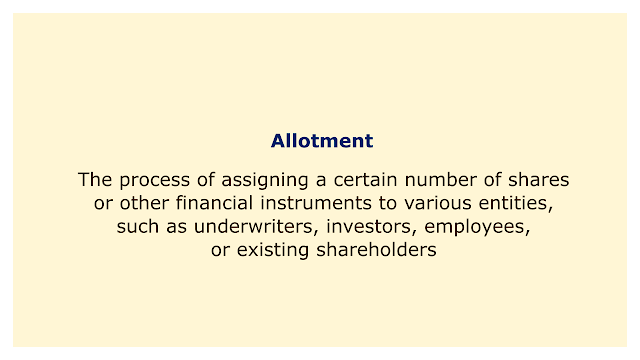 |
| Image: Moneybestpal.com |
The term "allotment" describes the distribution of shares or other financial instruments to various entities in a corporate environment.
It can also happen in other circumstances, such as stock splits, rights issues, and employee stock options. It is frequently employed in connection with public share issuances, such as initial public offers (IPOs).
Allotment can occur in different scenarios, such as:
What is Allotment?
Allotment is the process of assigning a certain number of shares or other financial instruments to various entities, such as underwriters, investors, employees, or existing shareholders. The purpose of allotment is to distribute equity among various stakeholders or to raise funds for the corporation issuing the stock.Allotment can occur in different scenarios, such as:
- IPOs: A private firm typically hires one or more underwriters to assist with the process when it decides to go public and sell its shares to the general public for the first time. Financial institutions known as underwriters consent to purchase and sell shares on the company's behalf. An allocation of shares is given to the underwriters by the firm, which they then distribute to its clients or resell on the open market. As the underwriters must predict the demand and price of the shares prior to the IPO, the allotment procedure in an IPO can be challenging. If demand exceeds expectations, the IPO will likely be oversubscribed, and the underwriters may decide to distribute fewer shares to each investor than they had asked. Should the demand
- Stock splits: A stock split occurs when a business decides to issue new shares to current shareholders proportionately in order to increase the number of its outstanding shares. For instance, if a business with 100 million existing shares decides to split those shares into two for one, it will issue an additional 100 million shares and distribute them to its shareholders, giving each of them two times as many shares as they had before. A stock split is intended to convey investor confidence in the company's growth potential while also making shares more accessible and liquid for investors. Although a stock split may have an impact on share price and trading volume, it has no impact on the company's market value or earnings per share.
- Rights issues: A rights issue is when a business gives its present shareholders the chance to purchase additional shares at a reduced price, typically in proportion to their current ownership. For instance, if a business issues 20 million new shares at $10 each and has 100 million outstanding shares, it may provide each shareholder one right to purchase one new share at $10 for every five shares they now own. The shareholders have three options: sell their rights to other investors, let their rights expire, or exercise their rights and purchase the new shares. Through a rights issue, a corporation can obtain money without eroding the ownership position of its current shareholders.
- Employee stock options: Employee stock options are contracts that grant employees the right to purchase a set number of business shares at a defined price within a predetermined time frame. For instance, if an employee is granted 1,000 stock options with a $20 exercise price and a five-year expiration date, they are able to purchase 1,000 shares of the company at $20 at any point during that five-year period. The employee has three options: exercise them and purchase the shares, sell them to additional investors, or let them expire. Employee stock options are intended to encourage and reward staff for their efforts and commitment.
Factors Affecting Allotment
The allotment process can be influenced by various factors, such as:- Demand and supply: Share prices and other financial instruments market quantities are determined by supply and demand. Price will increase and quantity will drop if there is a greater demand than there is a supply for something. Price will decrease and quantity will rise if demand is less than supply. Many variables, including market conditions, investor mood, corporate performance, industry trends, etc., can influence both supply and demand.
- Underwriting agreement: The underwriting agreement is a document that outlines the terms and circumstances of the share issuance and is made between the issuing company and the underwriters. It contains information about the number of shares that will be issued, their price range, the underwriters' fees, and commissions, how the shares will be distributed among the various entities, etc. The underwriting agreement may be a best effort or a binding commitment. Under a firm commitment agreement, the underwriters promise to purchase all of the company's shares and take on the risk of their market sale. The underwriters commit to selling the shares on the company's behalf in a best-efforts agreement, but they are not obligated to sell them altogether.
- Allocation method: The allocation method involves dividing up the shares or other financial instruments among various parties, such as underwriters, investors, staff members, or current shareholders. Either a proportional or a discretionary allocation technique can be used. A fixed ratio or formula based on existing ownership, subscription amount, etc. is used to distribute the shares in a proportional allocation. In a discretionary allocation, the shares are distributed depending on the underwriters' or the issuing company's opinion or preferences, such as the caliber of the investors, their relationship, etc.
